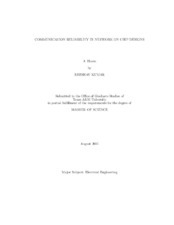| dc.contributor.advisor | Choi, Seong Gwan | |
| dc.creator | Kumar, Reeshav | |
| dc.date.accessioned | 2012-10-19T15:29:24Z | |
| dc.date.accessioned | 2012-10-22T17:58:34Z | |
| dc.date.available | 2012-10-19T15:29:24Z | |
| dc.date.available | 2012-10-22T17:58:34Z | |
| dc.date.created | 2011-08 | |
| dc.date.issued | 2012-10-19 | |
| dc.date.submitted | August 2011 | |
| dc.identifier.uri | https://hdl.handle.net/1969.1/ETD-TAMU-2011-08-10080 | |
| dc.description.abstract | The performance of low latency Network on Chip (NoC) architectures, which incorporate fast bypass paths to reduce communication latency, is limited by crosstalk induced skewing of signal transitions on link wires. As a result of crosstalk interactions between wires, signal transitions belonging to the same flit or bit vector arrive at the destination at different times and are likely to violate setup and hold time constraints for the design. This thesis proposes a two-step technique: TransSync- RecSync, to dynamically eliminate packet errors resulting from inter-bit-line transition skew. The proposed approach adds minimally to router complexity and involves no wire overhead. The actual throughput of NoC designs with asynchronous bypass designs is evaluated and the benefits of augmenting such schemes with the proposed design are studied. The TransSync, TransSync-2-lines and RecSync schemes described here are found to improve the average communication latency by 26%, 20% and 38% respectively in a 7X7 mesh NoC with asynchronous bypass channel.
This work also evaluates the bit-error ratio (BER) performance of several existing crosstalk avoidance and error correcting schemes and compares them to that of the proposed schemes. Both TransSync and RecSync scheme are dynamic in nature and can be switched on and off on-the-fly. The proposed schemes can therefore be employed to impart unequal error protection (UEP) against intra-flit skewing on NoC links. In the UEP, a larger fraction of the energy budget is spent in providing protection to those parts of the data being transmitted on the link which have a higher priority, while expending smaller effort in protecting relatively less important parts of the data. This allows us to achieve the prescribed level of performance with lower levels of power. The benefits of the presented technique are illustrated using an H.264 video decoder system-on-chip (SoC) employing NoC architecture. We show that for Akyio test streams transmitted over 3mm long link wires, the power consumption can be reduced by as much as 20% at the cost of an acceptable degradation in average peak signal to noise ratio (PSNR) with UEP. | en |
| dc.format.mimetype | application/pdf | |
| dc.language.iso | en_US | |
| dc.subject | NoC | en |
| dc.subject | Latency | en |
| dc.subject | Synchronization | en |
| dc.subject | Asynchronous bypass | en |
| dc.subject | Crosstalk | en |
| dc.subject | Skew | en |
| dc.subject | Communication Reliability | en |
| dc.title | Communication Reliability in Network on Chip Designs | en |
| dc.type | Thesis | en |
| thesis.degree.department | Electrical and Computer Engineering | en |
| thesis.degree.discipline | Electrical Engineering | en |
| thesis.degree.grantor | Texas A&M University | en |
| thesis.degree.name | Master of Science | en |
| thesis.degree.level | Masters | en |
| dc.contributor.committeeMember | Hu, Jiang | |
| dc.contributor.committeeMember | Silva Martinez, Jose | |
| dc.contributor.committeeMember | Kim, Eun Jung | |
| dc.type.genre | thesis | en |
| dc.type.material | text | en |


